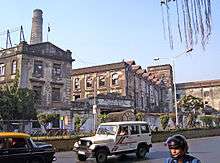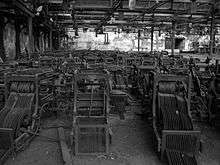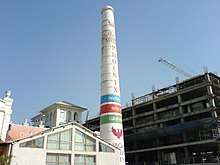Redevelopment of Mumbai mills

The redevelopment of Mumbai's cotton mills began in 1992, when efforts began to demolish the numerous cotton mills that once dotted the landscape of Mumbai, India, to make way for new residential and commercial buildings, as part of the wider modernization of Mumbai.
The cotton mill era and its decline
The mills of Girangaon were once integral to Mumbai's economy, particularly during the British colonial period, when Mumbai (then known as Bombay) was often referred to as the "Manchester of the East".[1] However, with the development of newer industries in and around Mumbai, these mills ceased to be profitable, and fell into a state of disrepair.
In the first half of the nineteenth century, India exported cotton to Britain, and then reimported the textile. In 1820, the total textile import was valued at Rs. 350,000. However, the cost had escalated significantly by 1860, when textile imports stood at Rs. 19.3 million. The impetus towards the founding of a cotton industry came from Indian entrepreneurs. The first Indian cotton mill, "The Bombay Spinning Mill", was opened in 1854 in Bombay by Cowasji Nanabhai Davar. Opposition from the Lancashire mill owners was eventually offset by the support of the British manufacturers of textile machinery.
The cotton mills of Bombay, and the rest of India, were owned and managed mainly by Indians. The initial investments came from families of the mill-owners, mainly obtained from trading. Later, when shares became available to the public, much of the ownership still remained Indian – of the 53 mills in the city in 1925, only 14 were British-owned. The management and directorships of these mills were also mainly Indian; of the 386 directorships recorded in 1925, only 44 were English.
By 1870, there were 13 mills in Bombay. Cotton exports grew during the American Civil War, when supplies from the United States's cotton plantations were interrupted. At the end of 1895, there were 70 mills; growing to 83 in 1915. A period of stagnation set in during the recession of the 1920s. In 1925, there were 81 mills in the city. After World War II, under strong competition from Japan, the mills declined. In 1953, there remained only 53 active mills in the city.[2]

Gradually, the government relaxed its norms that once restricted the redevelopment of mill lands, and as a result, numerous high-profile builders quickly took possession of these land parcels. Between 1990 and 2010, the majority of these mill lands were acquired and redeveloped.


List of mills in Mumbai
The table below lists the names and district locations of Mumbai's former mills, and the structures (if any) that stand on their land today. This list is not exhaustive.
| Name of former mill | Location | New development |
|---|---|---|
| Ambika Mills | Worli | Namaste Tower |
| Apollo Mills (South) | Mahalaxmi | Lodha Bellissimo/Primero |
| Bharat Mills | Lower Parel | India Bulls Blu |
| Bombay Dyeing & Manufacturing Company | Worli | Hard Rock Café[3] / ICC Bombay Realty |
| Bombay Dyeing (Spring Mills) | Dadar | Spring Mills tower |
| Bradbury Mills | Jacob Circle | No development |
| Century Spinning & Weaving Mills | Worli | Century Bazaar |
| China Mill compound | Sewri | Dosti Flamingos[4] |
| Dawn Mills | Lower Parel | Peninsula/Piramal Project |
| Digvijay Mills | Kalachowkie | No development |
| Elphinstone Mills (South) | Elphinstone | Indiabulls Finance Centre and Indiabulls Sky Suites |
| Gokuldas Morarjee Mills no.1 | Parel | Ashok Towers[5] |
| Gokuldas Morarjee Mills no.2 | Lower Parel | Peninsula Corporate park |
| Gold Mohur Mills | Dadar | No development |
| Hindoostan Spinning & Weaving Mills No.1 | Jacob Circle | Raheja Vivarea |
| Hindoostan Spinning & Weaving Mills no.2 | Jacob Circle | Kalpataru Heights |
| Hindoostan Spinning & Weaving Mills no.3 (Crown Mills) | Prabhadevi | Orchid Crown |
| India United Dye Works no.6 (North) | Prabhadevi | India International Trade Center |
| India United Mills no.1 (North) | Parel/Currey Road | No development |
| India United Mills no.2 | Kalachowkie | MCGM |
| India United Mills no.3 | Kalachowkie | MCGM |
| India United Mills no.4 | Kalachowkie | MHADA |
| India United Mills no.5 | Byculla | No development |
| India United Mills no.6 | Mahim | No development |
| Jam Mills | Lalbaug | MHADA |
| Jupiter Mills (South) | Lower Parel | Indiabulls Sky[6] |
| Kamala Mills | Lower Parel | Kamala City |
| Khatau Makanji Spinning & Weaving Mills | Jacob Circle | Marathon-Adani(under construction) |
| Kohinoor Mills No.1 (North) | Dadar (E) | No development |
| Kohinoor Mills No.2 (North) | Dadar (E) | No development |
| Kohinoor Mills No.3 (North) | Dadar(W) | Kohinoor Mill Mall[7] |
| Mafatlal Mills no.1 | Byculla | Piramal Aranya |
| Mafatlal Mills no.2 | Byculla | |
| Mafatlal Mills no.3 | Lower Parel | Marathon Futurex |
| Matulya Mills | Lower Parel | Sun Palazzo |
| Mukesh Textile Mills | Colaba | Venue for Bollywood filming |
| Modern Mills | Jacob Circle | Mahindra Belvedere Court |
| Morarjee Textile Mills | Parel | Ashok Towers |
| Mumbai Textile Mills (Sakseria Mills) | Lower Parel | DLF Place |
| New City of Bombay Mfg Mills | Kalachowkie | No development |
| New Great Eastern Spinning & Weaving Mills | Byculla | Peninsula Land (under construction) |
| New Hind Textile Mills | Byculla | MHADA |
| New Islam Mills | Lower Parel | One Avighna Park |
| Phoenix Mills | Lower Parel | High Street Phoenix |
| Piramal Spinning & Weaving Mills | Lower Parel | Marathon Nextgen by Marathon Group |
| Poddar Mills | Mahalaxmi | No development |
| Poddar Processors (Edward Mills) | Lower Parel | Indiabulls Bleu |
| Prakash Cotton Mills | Worli | No development |
| Raghuvanshi Mills | Lower Parel | K-lifestyle |
| Ruby Mills | Dadar | Ruby Corporate Park |
| Shakti Mills | Mahalaxmi | No development |
| Shree Madhusudan Mills (South) | ||
| Shree Ram Mills | Worli | Palais Royale, Mumbai |
| Shriniwas Mills | Lower Parel | World One |
| Simplex Mills | Jacob Circle | Planet Godrej |
| Sitaram Mills | Mahalaxmi | MCGM |
| Standard Mills | Prabhadevi | Sheth Beaumonde and Chaitanya Towers |
| Sun Mills Compound | Lower Parel | Zenzi Mills Club / Lokhandwala Victoria |
| Swadeshi Mills | Kurla | Swadeshi Garden |
| Swan Mills | Sewri | Ashok Gardens[8] |
| Tata Mills (North) | Dadar (E) | No development |
| Victoria Mills | Lower Parel | Victoria House (Commercial) & Car park |
| Western India Spinning & Weaving Mill | Kalachowkie | No development |
See also
References
- ↑ "The Paradox of Mumbai: Slums, Stocks, Stars and the New India - SPIEGEL ONLINE - News - International". Spiegel.de. Retrieved 2011-10-26.
- ↑ "The Cotton Mills: Mumbai/Bombay pages". Theory.tifr.res.in. Retrieved 2011-10-26.
- ↑ "Hard Rock Cafe MUMBAI". Hardrock.com. 2006-09-12. Retrieved 2011-10-26.
- ↑ "Dosti Group". Dosti Group. Archived from the original on 2012-07-24. Retrieved 2011-10-26.
- ↑ "Projects". Peninsula. Archived from the original on 2011-11-07. Retrieved 2011-10-26.
- ↑ "Indiabulls Sky". Indiabulls.com. Retrieved 2011-10-26.
- ↑ "The Hindu : National : Kohinoor Mills land sale: Shiv Sena changing stance?". Hinduonnet.com. 2005-09-07. Retrieved 2011-10-26.
- ↑ "Projects". Peninsula. Archived from the original on 2011-11-13. Retrieved 2011-10-26.
External links
| Wikimedia Commons has media related to Mills in Mumbai. |
- "The Cotton Mills" – article by Tata Institute of Fundamental Research, Mumbai